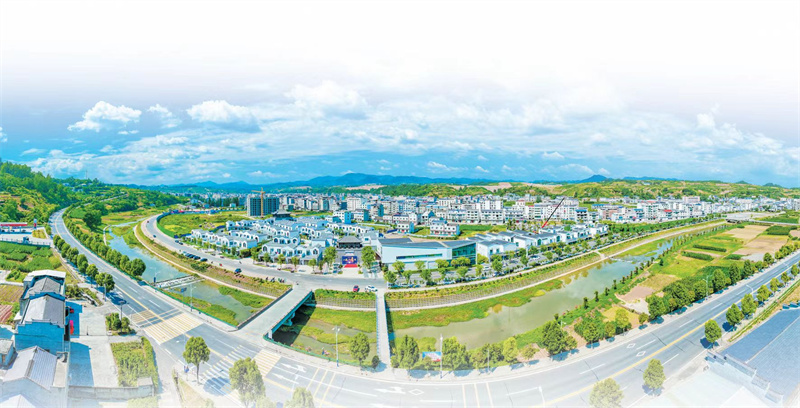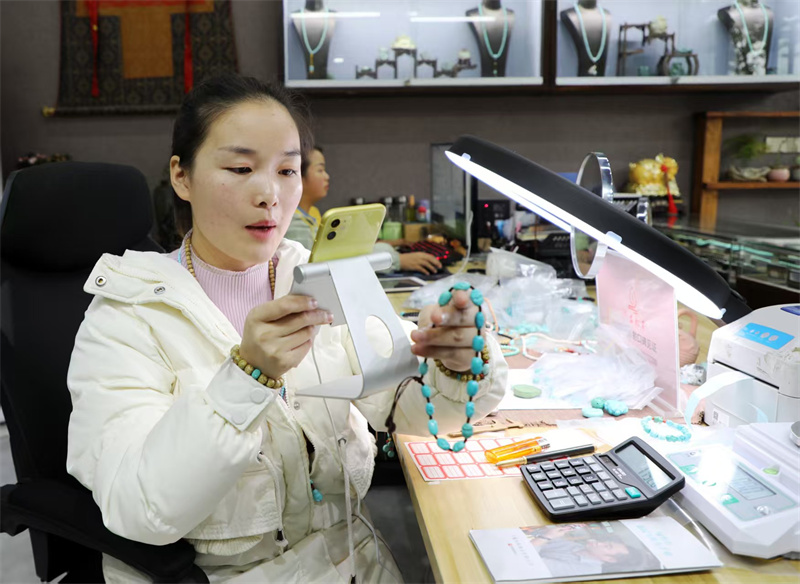




- BRNN
- BRI News
- BRNN News
- Database
Official Documents Polices and Regulations
Inter-government Documents International Cooperation BRI Countries
Business Guide Economic Data BRI Data
Trade
Investment Projects Latest projects
Cases - Content Pool

Photo shows a panoramic view of the international jewelry trading center in Zhushan county, central China's Hubei Province. (Photo courtesy of the media convergence center of Zhushan county)
Rough chunks of turquoise are being transformed into treasures by skilled artisans, fueling the booming turquoise industry in Zhushan county, central China's Hubei Province.
In Majiadu town's Yingpanhe village, one of China's first designated "Taobao villages"—rural e-commerce hubs supported by Alibaba's logistics, services, and training—more than 1,100 turquoise shops now line the streets. Livestreaming marketing has been employed to boost sales. So far this year, the town's e-commerce sales have reached 1.5 billion yuan (about $210.68 million).
At the Douyin e-commerce livestreaming base, 1,922 merchants have gathered, completing 4.5 million orders annually with a total transaction volume of 3.5 billion yuan.
"We used to wait at our stalls for customers to come. Now we can sell nationwide through our phones, and our income has doubled," said shop owner Luo Jingjing, who once worried about her store's sporadic orders. Today, she leads a 40-member livestreaming team that sells turquoise bracelets to Europe and the U.S. "Annual sales have grown a hundredfold, reaching tens of millions of yuan," she added.

A livestreamer promotes a turquoise product in Zhushan county, central China's Hubei Province. (Photo courtesy of the convergence media center of Zhushan county)
To boost e-commerce, Zhushan county has upgraded infrastructure, expanded network coverage, strengthened logistics systems, and launched targeted talent training programs. It has organized 19 large-scale training sessions, cultivating over 3,000 industry professionals, including more than 110 e-commerce livestreamers. This digital transformation has brought Zhushan's once-hidden turquoise to global markets, building an industrial chain with an annual output value of 20 billion yuan.
Inside the international turquoise museum in Zhushan county, excavated artifacts reveal the gemstone's deep historical roots, affirming its unique place in Chinese civilization.
On Nov. 8, the international jewelry trading center in Zhushan county hosted a turquoise fashion show. Models walked the runway wearing turquoise jewelry that blended traditional motifs with contemporary aesthetics, as more than 500 brand representatives, designers, and industry experts from around the world gathered to witness the ancient gemstone's modern transformation.
The 11,000-square-meter international jewelry trading center has become a cultural landmark where tradition meets innovation.

An artisan works on a turquoise artwork in Zhushan county, central China's Hubei Province. (Photo courtesy of the convergence media center of Zhushan county)
At the carving workshop in the international turquoise industrial park in the county, Qin Lipeng, winner of the Tiangong Award, the most influential award for China's jade carving and stone carving, guided his apprentice in carving a Tibetan Buddhist statue.
"Training a qualified carver takes at least five years," said Tao Chong, curator of the international turquoise museum in Zhushan county, acknowledging that a shortage of skilled talent was once the biggest bottleneck to industry development.
To address this, Zhushan Vocational and Technical School established a turquoise college in 2019, adopting an innovative model that integrates cooperation with enterprises and master carvers. Today, most graduates from the first cohort have become technical leaders at local enterprises, injecting new vitality into Zhushan's turquoise sector.

Tel:86-10-65363107, 86-10-65368220, 86-10-65363106